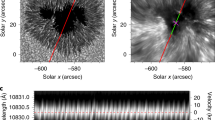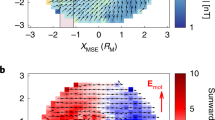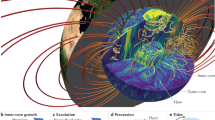Abstract
One of the most important results of the Giotto mission to comet Halley was the discovery of a magnetic cavity surrounding the nucleus in which the magnetic field strength was apparently zero1. The boundary of the cavity, the ionopause, occurred at 4,760 km (3,840 km) and the maximum magnetic field strength was ∼55 nT (65 nT), thousands of km outside the rather sharply defined transition to zero field on the inbound (outbound) part of the trajectory, respectively. We show here with the aid of a simple model that such a magnetic field structure can be explained as being largely the result of ion-neutral friction2 rather than simple pressure-balance alone3,4.
This is a preview of subscription content, access via your institution
Access options
Subscribe to this journal
Receive 51 print issues and online access
$199.00 per year
only $3.90 per issue
Buy this article
- Purchase on Springer Link
- Instant access to full article PDF
Prices may be subject to local taxes which are calculated during checkout
Similar content being viewed by others
References
Neubauer, F. M. et al. Nature 321, 352–355 (1986).
Ip, W.-H. & Axford, W. I. in Comets (ed. Wilkening, L. L.) 588–634 (University of Arizona Press, Tucson, 1982).
Schmidt, H. U. & Wegman, R. in Comets (ed. Wilkening, L. L.) 538–560 (University of Arizona Press, Tucson, 1982).
Wallis, M. K. & Dryer, M. Astrophys. J. 205, 895–899 (1976).
Axford, W. I., Cunnold, D. M. & Gleeson, L. J. Planet. Space Sci. 14, 909–919 (1966).
Riedler, W., Schwingenschuh, K., Yeroshenko, Ye. G., Styashkin, V. A. & Russell, C. T. Nature 321, 288–299 (1986).
Balsiger, H. et al. Nature 321, 330–334 (1986).
Krankowsky, D. et al. Nature 321, 326–329 (1986).
Mendis, D. A., Houpis, H. L. F. & Marconi, M. L. Fundamentals cosm. Phys. 10, 1–380 (1985).
Elphic, R. C. et al. J. geophys. Res. 85, 7679 (1980).
Galeev, A. A. & Lipatov, A. S. Adv. Space Res. 4, 229–257 (1984).
Ershkovich, A. I. & Mendis, D. A. Astrophys. J. 302, 849 (1986).
Author information
Authors and Affiliations
Rights and permissions
About this article
Cite this article
Ip, WH., Axford, W. The formation of a magnetic-field-free cavity at comet Halley. Nature 325, 418–419 (1987). https://doi.org/10.1038/325418a0
Received:
Accepted:
Issue Date:
DOI: https://doi.org/10.1038/325418a0
This article is cited by
-
Plasma Flow and Related Phenomena in Planetary Aeronomy
Space Science Reviews (2008)
-
Interception of comet Hyakutake's ion tail at a distance of 500 million kilometres
Nature (2000)
-
Single particle approximation for the inner coma of comet Halley
Earth, Moon, and Planets (1993)
-
The stability of inner cometo-sheath with large Larmor radius effects
Astrophysics and Space Science (1993)
-
Stability of the cometary ionopause
Astrophysics and Space Science (1992)
Comments
By submitting a comment you agree to abide by our Terms and Community Guidelines. If you find something abusive or that does not comply with our terms or guidelines please flag it as inappropriate.



